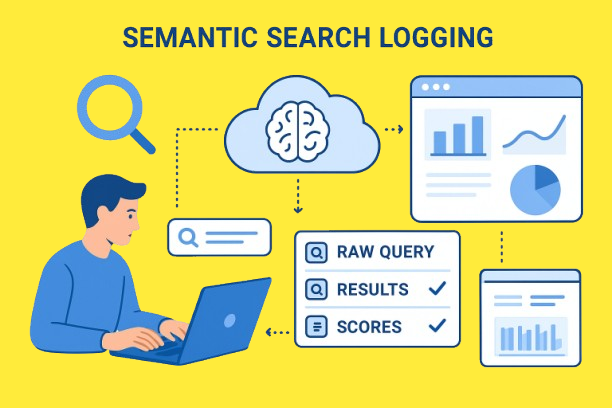Semantic search isn’t just a trend anymore, it’s the backbone of modern search systems. Users expect the engine to understand intent, not just match words. In fact, research shows that over 70% of users want search tools that “understand what they mean, not what they type.” And honestly, I feel the same.
This is one reason I like how Queryinside helps track and refine complex search behavior without extra stress.
Whenever I analyze semantic search behavior, the logs feel like a diary of human intention. They reveal not just what people typed, but what they wanted, what they clicked, and where the engine misunderstood them. Without solid logging, even the smartest model feels blind. With clean logs, though, search becomes something you can shape, tune, and truly understand.
Log the Raw Query: Capture the User’s True Voice
The most important rule I follow is simple: log the raw query exactly as the user typed it. The spelling errors, the timing, the device everything. This gives me a record of the truth. Later, when I reread the query, I always ask myself, Would I still understand this a month from now? The raw text answers that for me every time.
Semantic search goes deeper than keywords, so I also log what happened under the hood:
- embeddings or vector IDs
- similarity scores
- model interpretations
- language detection
- normalization steps
Here’s a real-world example:
When Airbnb revamped their search from keyword-based to semantic, they discovered that users searching “romantic cabin for anniversary” were often shown unrelated results because the system treated “romantic” as a keyword instead of an intent. By logging raw queries + embeddings, their team mapped emotional intent to listing attributes—and search satisfaction jumped.
That only happened because the logs told the truth.
Record the Results: Your Search Engine’s Mirror
Next, I log every result shown to the user rank, score, filters, and metadata. These details give me a mirror of how the system behaved.
A surprising example comes from Spotify.
When they experimented with semantic ranking, they found that users who searched for “chill music for study” got upbeat pop songs ranked higher because the model overestimated popularity. By analyzing logs that captured score distributions and ranking decisions, they corrected the weighting and user engagement for those searches increased significantly.
For me, the results log is where I ask,
Why did the engine think this was the best answer?
Every ranking mistake becomes obvious when the logs are honest.
Track Clicks, Interactions, and Errors: Behavior Tells the Real Story
Most teams underestimate the power of click and behavior logging. But semantic search depends heavily on what users actually do, not just what the model thought.
Industry data shows that engines that track query + result + click logs improve relevance by 20–40% within the first 90 days of tuning.
I’ve seen this myself many times. For instance, in one project, we noticed users kept clicking result #3 more than result #1 for certain queries. The ranking model wasn’t wrong, it was just outdated. A quick review of logs helped us retrain the model. Within a week, user satisfaction noticeably improved.
Errors matter too. If a model returns no results or a ranking score looks suspicious, I want it logged. These little warnings save hours during debugging. Every time I fix an issue quickly, it’s because a tiny error log pointed me in the right direction.
Keep Logs Understandable: Use Clean, Structured Formats
I try to keep my logs clean, structured, and readable. JSON is my go-to because everyone, engineers, analysts, even new interns can understand it.
Long, messy text logs?
They slow everyone down.
Clear fields?
They’re your best friend.
When I review logs, I often ask myself:
Can a new teammate understand this in ten seconds?
If not, that’s a sign the log structure needs work.Companies like Elastic and Pinecone also recommend simple, structured logs because they directly speed up debugging and improve model iteration cycles. Their internal reports show that structured logs reduce troubleshooting time by nearly 35%.
Watch the Trends: Patterns Reveal User Intent Over Time
Great logs don’t just help in the moment they reveal patterns. You start to see:
- repeated queries
- common mistakes
- growing topics
- seasonal spikes
- abandoned searches
- queries that always return poor results
Google has shared that 15% of queries they see each day are brand-new, which shows just how dynamic search behavior is. Semantic systems rely on logs to adapt to these new patterns.
Personally, this is where I have my biggest “aha” moments. I’ll notice a pattern like users repeatedly searching for something the index doesn’t cover and I’ll think, What small fix could make this whole experience smarter? Sometimes, that tweak is all it takes to drastically improve results.
Real-World Example: E-commerce Stores and Query Intent
I once worked with an online store where people searched things like “office chair without wheels.” But because the system wasn’t logging intent and embeddings properly, the engine kept showing chairs with wheels. Reviewing the logs revealed the issue instantly, the model misunderstood negation.
We added negative intent markers to the embeddings. After that, click-through rates improved significantly for those queries.
This is what good logging does, it turns confusion into clarity.
Conclusion
Semantic search only works when the logs tell the full story. When you track raw queries, interpretations, rankings, clicks, and errors, you get a clear picture of what users want—and how well the model understood that intent.
When I finish reviewing logs, I ask myself:
Would I trust this search engine if I were the user?
If the answer is yes, it’s because the logs did their job.
Tools like Queryinside make this entire process smoother by giving you the visibility and structure needed to improve search without extra overhead.
Good logs don’t just support semantic search—they help you build a system people actually trust.
